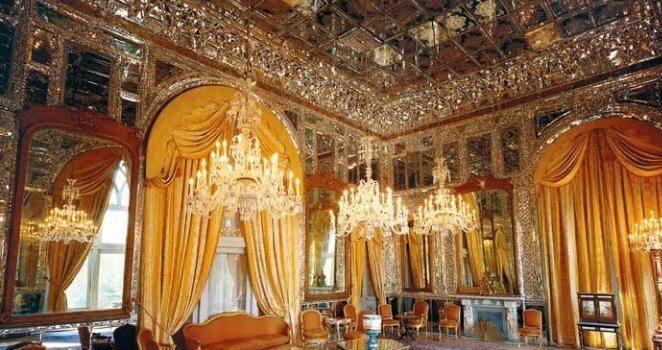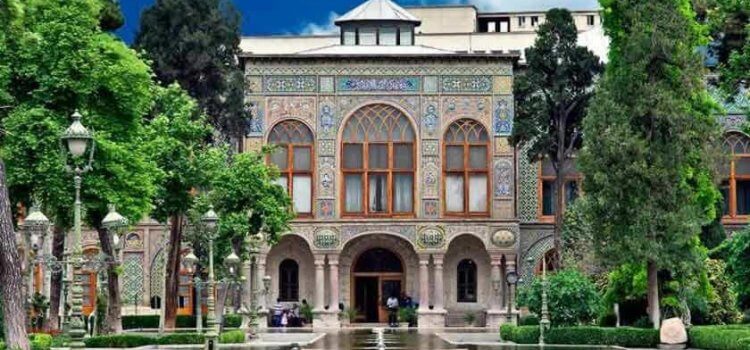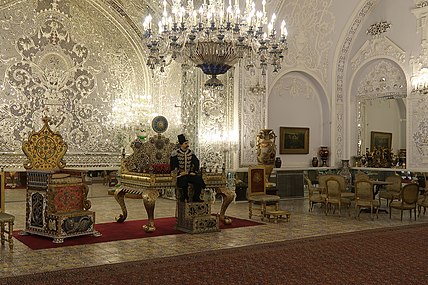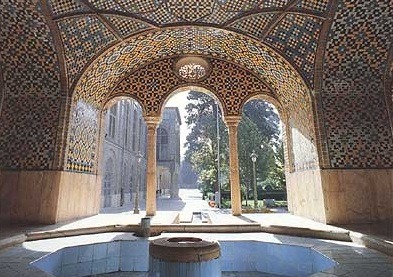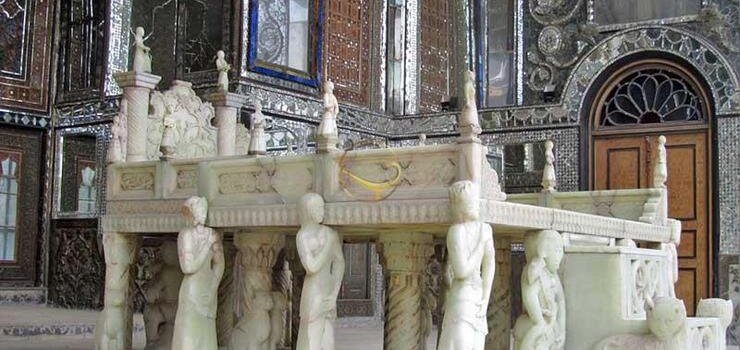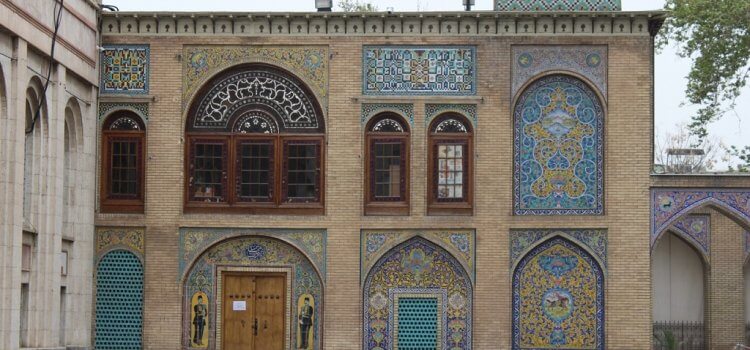Mirror Hall
The Mirror Hall and Salam Hall were built concurrently in 1874 to safeguard the Peacock Throne and the Imperial Throne.
The Mirror Hall and Salam Hall were built concurrently in 1874 to safeguard the Peacock Throne and the Imperial Throne. Abdul Hassan Mernār-bashi, also known as Sani’ al-Molk, had worked on the design of the hall in close cooperation with the then construction minister Mirza Yahyä Khan Moatamed At-Molk. On completion, renowned painter Kamal Al-Molk started working on his famous painting of the Mirror Hall. Incidentally, some jewels from the peacock Throne were stolen, thus putting the painter under suspicion and prolonging his work by five years.
Aaj (Ivory) Hall
Aaj is a Turkish word for “hunger” and the hall where the king’s guests were served food has, thus, become known as Aaj Hall. A note of caution, nonetheless, seems necessary here. In Persian, the word for ivory has exactly the same pronunciation as the word for hunger in Turkish, namely Aaj, and since there is a pair of elephant tusks in this hall, a gift to Mohammad Reza Pahlavi from the government of India, many Iranian visitors call the Aaj Hall the Ivory Hall.
Golestan Palace
Golestan Palace, or the Palace of Flowers, houses some of the capital’s oldest royal buildings and is one of the most prominent historic complexes in Iran.
Golestan Palace, or the Palace of Flowers, houses some of the capital’s oldest royal buildings and is one of the most prominent historic complexes in Iran. During the Qajar rule, this now UNESCO World Heritage site was considered as the political capital of the Qajar dynasty. It witnessed coronations of seven Qajar rulers as well as both of the Pahlavi kings.
As most of the buildings within the site date to the Qajar era, it is generally perceived as a Qajar palace complex. The true history of its origins, however, stretches far back to the Safavid period when, in 1580, Shāh Abbās I built a citadel in Tehran. Later on, between 1760 and 1767, Karim Khan Zand built a divān-khāneh (court or seat of the government) within the Safavid citadel and changed the main design of the complex. At present, only the Marble Throne Veranda and Karim Khāni Nook date to this period.
After Karim Khan’s death, Agha Mohammad Khan, the founder of the Qajar dynasty, took advantage of the ensuing civil unrest in Iran and expanded Qajar territory up to the cities of Tehran and Damghan. In 1795, he defeated the last king of the Zand Dynasty, Lotf Ali Khan, conquered Tehran the following year and declared himself the King of Iran. Aghā Mohammad Khan’s coronation at the Golestan Palace turned it into a place of unrivalled importance among the Qajar kings. Fat’h Ali Shah (1772-1834), who was also crowned here, commissioned further decoration and expansion of the palace complex.
Nāser al-Din Shah, impressed by the palaces he had visited in Europe, had the Palace extensively renovated, having it almost entirely reshaped. The complex did not undergo almost any changes until the fall of the Qajar dynasty in 1925.
Golestan Palace has subsequently witnessed coronations of the Pahlavi kings. During the reign of Reza Shah Pahlavi, all the surrounding buildings known as andaruni or haramsara (domestic spaces that are reserved for the women of the palace and are inaccessible to adult males except for close relations) were completely demolished. These andaruni spaces, known as Farah-ābād during the reign of Fat’h Ali Shah, consisted of several interconnected, exquisite yards surrounded by rooms of various sizes intended for female dwellers of the royal harem who would spend their allocated time with the monarch here. There have always been numerous stories surrounding the haramsara, as told by the favorite wives of the kings, or stories about the famous clown Aziz al-Soltan or the coquetries of Babri Khan, the royal cat whose sudden disappearance made the residents of haramsara melancholic.
Salam Hall (Audience Hall) or Museum Hall
As a passionate collector of unique pieces of art, Naser al-Din Shah converted the Salam Hall into a royal museum, so the valuable gifts from European officials could be kept there.
As a passionate collector of unique pieces of art, Naser al-Din Shah converted the Salam Hall into a royal museum, so the valuable gifts from European officials could be kept there. He also ordered the demolition of Emarat-e Biruni (outdoor mansion), which had previously been used as the palace museum. The hall, nonetheless, continued to be used for the coronation of some Qajar kings and several royal receptions. The Salam Hall is also adorned with large, attractive chandeliers and eye-catching paintings by Kamäl al-Molk. To celebrate the coronation of Mohammad Reza Pahlavi, the objects on display in this hall were rearranged to what it looks like today.
Karim Khani Nook
Next to the Marble Throne Veranda, there is the second Zand monument, the Karim Khani Nook or Karim Khani Veranda which was Naser al-Din Shah’s favorite place of retreat, where he spent long hours in solitude.
Next to the Marble Throne Veranda, there is the second Zand monument, the Karim Khani Nook or Karim Khani Veranda which was Naser al-Din Shah’s favorite place of retreat, where he spent long hours in solitude. When looking at its earlier photos, the veranda has, alas, lost some of its original features. The stairway leading to the Karim Khani Nook has a tragic story of its own. Out of long-nurtured hate for Karim Khan, Agha Mohammad Khan had the Zand monarch’s body disinterred and reburied under the stairway. Later in 1925, Reza Shah Pahlavi ordered for Karim Khan’s bones to be reburied next to the Safavid King, Shah Soltan Hosein, in Qom. Some historians insist, however, that the remains were brought back to the Karim Khan Zand’S original grave in Shiraz.
One of the most interesting objects in the Karim Khani Nook is the tombstone of Naser al-Din Shah, assassinated in 1896. Brought here from the Shah Abdol Azim Shrine, it is a single piece of marble stone, bearing a life-like relief of the king carved by Abbas Gholi. More interesting, however, is the story, or rather stories, about the king’s assassination.
One common version among various divergent versions is that on April 29, 1896 Naser al-Din Shih attended the Shah Abdol Azim Shrine in Rey for prayer. Unlike other occasions, however, he ordered for the shrine to be kept open to the public. A man known as Mir-za Reza Kermani, taking advantage of this situation and bearing a petition in his hand, approached the king to ask for his favor. Once at the right distance, he pulled out a handgun and shot the king in the heart. In an attempt to save Naser al-Din Shah, a chair was brought from the private tomb of Badr family, which he was seated on. Faded traces of the king’s blood are still visible on the chair, placed in a corner of the main hall of the palace for the visitors to have a look at.
The rumor has it that in order to avoid any social unrest following the king’s death, it was decided to keep Naser al-Din Shah’s murder secret. The dead body of the king was, thus, placed into the royal coach (now kept in the National Car Museum of Iran) and sent to the Golestan Palace. However, in addition to the corpse of Shah-e Shahid (the Martyr King), there was another man in the couch who impersonated Naser al-Din Shah. Wearing white gloves, he would at times wave at people or touch his moustache in the same way as the dead king used to do. Once in the Golestan Palace, the body of the dead king was buried for a period of one year in the Royal Tekiyeh and later moved to the Abdol Azim Shrine.
Marble Throne Veranda
In 1792, when Aghā Mohammad Khan conquered Shiraz, he had the paintings, curtains, mirrors, and marble slabs from Karim Khan’s citadel in Shiraz transferred to Tehran
In 1792, when Aghā Mohammad Khan conquered Shiraz, he had the paintings, curtains, mirrors, and marble slabs from Karim Khan’s citadel in Shiraz transferred to Tehran, which at that time already had a Zand divan-khāneh, and installed in the Marble Throne Veranda, built in 1807. The veranda contains elements from both Zand and Qajar periods.
In 1807, Fat’h Ali Shah ordered construction of a marble throne, which came to be known as Takht.e Tavous (the Peacock Throne), consisting in total of 65 pieces of marble brought from mines in Yazd, to be placed permanently in the veranda. Designed by Mirza Baba Shirazi (Naqqāsh Bāshi) and the stonecutter, Mohammad Ebrahim Esfahani, this 250-year-old throne was completed in four years, from 1747 to 1751. The jewel-studded throne is carried on the shoulders of angels and demons, referring to the story of Solomon’s flying throne. This is why the Peacock Throne is also called the Throne of Solomon. Seventeen verses on its upper side praise Fat’h Ali Shah and the throne itself.
The Marble Throne Veranda was used on ceremonial occasions and for royal receptions. During religious celebrations and other festivals, the king would sit on the throne while statesmen, royal courtiers, ambassadors and foreign envoys would pay him homage. In 1925, Reza Shah Pahlavi held a symbolic coronation in the Marble Throne Veranda before his official crowning.
Shamsol Emāreh
Based on the available documents, construction of Shamsol Emareh started in 1866 and lasted two years.
Based on the available documents, construction of Shamsol Emareh started in 1866 and lasted two years. Designed by Moayer Al-Mamölek and built by Ali Mohammad Kashi, this five-storey high building was meant to stand out against the backdrop of one-storey buildings ot Tehran and was. thus. named Shamsol Emareh, meaning “the sun of all buildings.” Besides its height, Shamsol Emāreh was also the first building in Iran to be constructed with iron girders. Its other notable feature is the clock tower, located in the middle of the upper floor facade. The clock was a gift to Naser al-Din Shah from Queen Victoria of England.
The fifth floor of Shamsol Emāreh was known as Kolah Farangi. From there, using simple binoculars, the king ‘s wives could enjoy a panoramic view of the city and the Alborz Mountains.
According to historical records, on the inaugural day of Shamsol Emareh, a royal commander, general Mirza Hossein Khan, whispered ill-tended words into the ears of Naser al-Din Shah that the royal treasury had to take full responsibility for the construction expenses of the monument. General Doost Ali Khan Moayer al-Mamalek, passing by the very same moment, pledged to the Shah to personally take care of the expenses.
The Wind-Tower Building
The Wind-Tower Building, built by the order of Fat’h Ali Shah in 1806, is surrounded by the most attractive places in the Golestan Palace.
The Wind-Tower Building, built by the order of Fat’h Ali Shah in 1806, is surrounded by the most attractive places in the Golestan Palace. The majestic monument is decorated using a variety of architectural art techniques including mirrors. incrustation, gilding, wood carving, etc. Sash windows installed in this building are characteristic of Iranian architecture.
The most conspicuous element of the building, however, is its four wind-towers trapping the wind and channelling it to Howz-Khaneh in the basement and then funnelling the cooled air back into the interior spaces. This ingenuity would ensure the flow of pleasant air inside the interior spaces. There have also been numerous stories associated with the Wind Tower Building. It is said that once, when Tehran was experiencing one of its hottest summers and Mozafar al-Din Shah was getting for his coronation, a decision was made to hold the coronation in this tower to escape the scorching heat.
Furthermore, Kamal al-Molk resided in this building for a while. During the rule of Mohammad Reza Pahlavi, it was used as the royal library. According to Moayer al-Molk, beautiful birds of different species were kept around the pool in the basement of the building. Presently, Howz Khaneh houses a photo-gallery, whose many photos were taken by Naser al-Din Shah himself.

